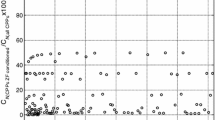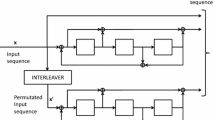Abstract
Quadratic permutation polynomials (QPPs) have been widely studied and used as interleavers in turbo codes. However, less attention has been given to cubic permutation polynomials (CPPs). This paper proves a theorem which states sufficient and necessary conditions for a cubic permutation polynomial to be a null permutation polynomial. The result is used to reduce the search complexity of CPP interleavers for short lengths (multiples of 8, between 40 and 352), by improving the distance spectrum over the set of polynomials with the largest spreading factor. The comparison with QPP interleavers is made in terms of search complexity and upper bounds of the bit error rate (BER) and frame error rate (FER) for AWGN and for independent fading Rayleigh channels. Cubic permutation polynomials leading to better performance than quadratic permutation polynomials are found for some lengths.
Similar content being viewed by others
References
Takeshita Y. O. (2007) Permutation polynomial interleavers: An algebraic-geometric perspective. IEEE Transactions on Information Theory 53(6): 2116–2132
Sun J., Takeshita Y. O. (2005) Interleavers for turbo codes using permutation polynomial over integers rings. IEEE Transactions on Information Theory 51(1): 101–119
Takeshita Y. O. (2006) On maximum contention-free interleavers and permutation polynomials over integers rings. IEEE Transactions on Information Theory 52(3): 1249–1253
Ryu J., Takeshita Y. O. (2006) On quadratic inverses for quadratic permutation polynomials over integers rings. IEEE Transactions on Information Theory 52(3): 1254–1260
Tărniceriu D., Trifina L., Munteanu V. (2009) About minimum distance for QPP interleavers. Annals of Telecommunications 64(11-12): 745–751
Rosnes, E., & Takeshita, Y. O. (2006). Optimum distance quadratic permutation polynomial-based interleavers for turbo codes. In Proceedings of IEEE international symposium on information theory, Seattle, USA, 1988–1992.
3GPP TS 36.212 V8.3.0 (2008-05). 3rd generation partnership project, multiplexing and channel coding (Release 8).
Zhao H., Fan P., Tarokh V. (2010) On the equivalence of interleavers for turbo codes using quadratic permutation polynomials over integer rings. IEEE Communications Letters 14(3): 236–238
Li, S. (2008). Null polynomials modulo m. Online available: http://arxiv.org/PS_cache/math/pdf/0509/0509523v6.pdf, 26 p. (last revised).
Trifina, L., Tărniceriu, D., Munteanu, V. (2011). Improved QPP interleavers for LTE standard. In IEEE international symposium on signals, circuits and systems ISSCS 2011 (pp. 403–406). Iasi, Romania.
Chen Y.-L., Ryu J., Takeshita O. Y. (2006) A simple coefficient test for cubic permutation polynomials over integer rings. IEEE Communications Letters 10(7): 549–551
Zhao H., Fan P. (2007) A note on a simple coefficient test for cubic permutation polynomials over integer rings. IEEE Communications Letters 11(12): 991
Hardy G. H., Wright E. M. (1995) An introduction to the theory of numbers, 4th ed. Oxford University Press, Oxford
Divsalar, D., Pollara, F. (1995). Turbo codes for PCS applications. In Proceedings of international conference on communications 1995 (pp. 54–59). Seattle, WA.
Benedetto S., Biglieri E. (1999) Principles of digital transmission: With wireless applications. Plenum, New York
Proakis J. G. (1995) Digital communications, 3rd ed. McGraw-Hill, New York
Yuan J., Feng W., Vucetic B. (2002) Performance of parallel and serial concatenated codes on fading channels. IEEE Transactions on Communications 50(10): 1600–1608
Garello R., Pierleoni P., Benedetto S. (2001) Computing the free distance of turbo codes and serially concatenated codes with interleavers: Algorithms and applications. IEEE Journal on Selected Areas in Communications 19(5): 800–812
http://www.tlc.polito.it/garello/turbodistance/turbodistance.html.
Author information
Authors and Affiliations
Corresponding author
Rights and permissions
About this article
Cite this article
Trifina, L., Tarniceriu, D. Analysis of Cubic Permutation Polynomials for Turbo Codes. Wireless Pers Commun 69, 1–22 (2013). https://doi.org/10.1007/s11277-012-0557-y
Published:
Issue Date:
DOI: https://doi.org/10.1007/s11277-012-0557-y




